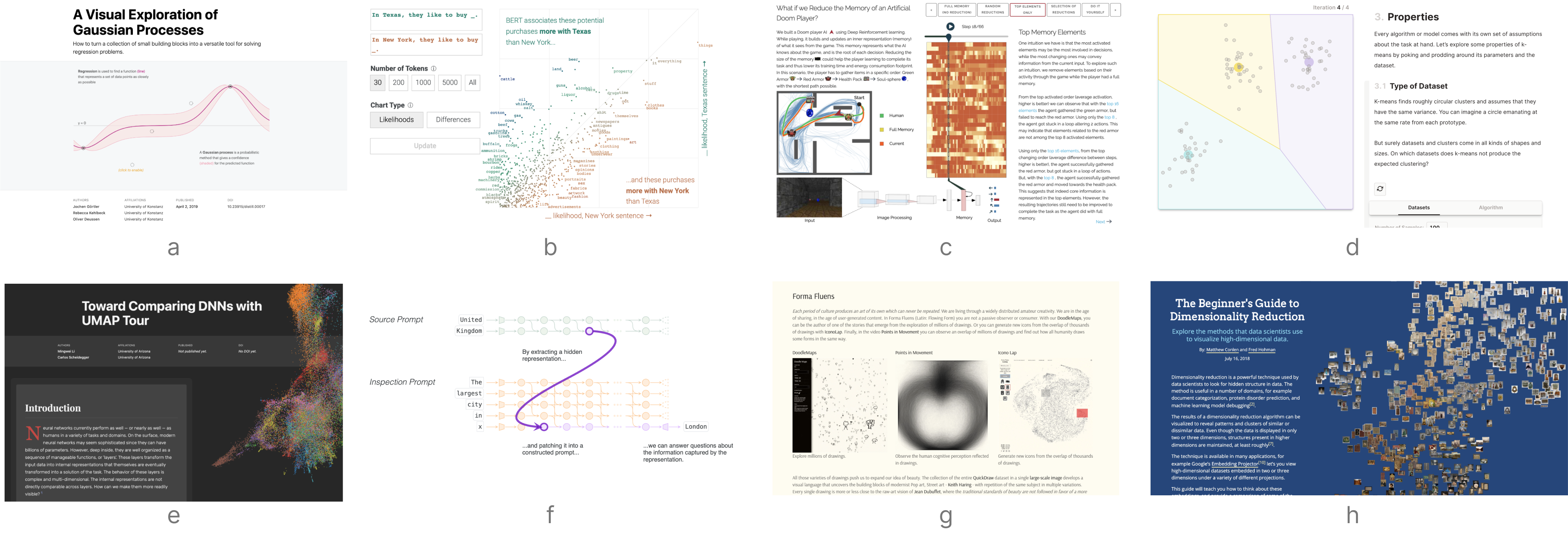
8th Workshop on
Visualization for AI Explainability
November ?, 2025 at IEEE VIS in Vienna, Austria
The role of visualization in artificial intelligence (AI) gained significant attention in recent years. With the growing complexity of AI models, the critical need for understanding their inner-workings has increased. Visualization is potentially a powerful technique to fill such a critical need.
The goal of this workshop is to initiate a call for "explainables" / "explorables" that explain how AI techniques work using visualization. We believe the VIS community can leverage their expertise in creating visual narratives to bring new insight into the often obfuscated complexity of AI systems.

Important Dates
July 30, 2025, anywhere: Submission Deadline
September 1, 2025: Author Notification
October 1, 2025: Camera Ready Deadline
Program Overview
Coming soon!
Call for Participation
Explainable submissions (e.g., interactive articles, markup, and notebooks) are the core element of the workshop, as this workshop aims to be a platform for explanatory visualizations focusing on AI techniques.
Authors have the freedom to use whatever templates and formats they like. However, the narrative has to be visual and interactive, and walk readers through a keen understanding on the ML technique or application. Authors may wish to write a Distill-style blog post (format), interactive Idyll markup, or a Jupyter or Observable notebook that integrates code, text, and visualization to tell the story.
Here are a few examples of visual explanations of AI methods in these types of formats:
- [interactive article] A Visual Exploration of Gaussian Processes
- [interactive article] Why Momentum Really Works
- [interactive article] A Visual Introduction to Machine Learning
- [interactive article] Art-Inspired Data Experiments on Neural Network Model Decay
- [interactive article] Attacking Discrimination with Smarter Machine Learning
- [markup] The Myth of the Impartial Machine
- [markup] The Beginner's Guide to Dimensionality Reduction
- [notebook] t-SNE Explained in Plain JavaScript
- [notebook] How to build a Teachable Machine with TensorFlow.js
- [notebook] Titanic Machine Learning from Disaster
While these examples are informative and excellent, we hope the Visualization & ML community will think about ways to creatively expand on such foundational work to explain AI methods using novel interactions and visualizations often present at IEEE VIS. Please contact us, if you want to submit a original work in another format. Email: orga.visxai (at) gmail.com.
Note: We also accept more traditional papers that accompany an explainable. Be aware that we require that the explainable must stand on its own. The reviewers will evaluate the explainable (and might chose to ignore the paper).
Hall of Fame
Each year we award Best Submissions and Honorable Mentions. Congrats to our winners!VISxAI 2024
- Can Large Language Models Explain Their Internal Mechanisms? -- Nada Hussein, Asma Ghandeharioun, Ryan Mullins, Emily Reif, Jimbo Wilson, Dr. Nithum Thain, Dr Lucas Dixon
- The Illustrated AlphaFold -- Elana P Simon, Jake Silberg
VISxAI 2023
- PAC Learning Or: Why We Should (and Shouldn't) Trust Machine Learning -- Dylan Cashman
- Understanding and Comparing Multi-Modal Models -- Christina Humer, Vidya Prasad, Marc Streit, Hendrik Strobelt
- Do Machine Learning Models Memorize or Generalize? -- Adam Pearce, Asma Ghandeharioun, Nada Hussein, Nithum Thain, Martin Wattenberg, Lucas Dixon
VISxAI 2022
- K-Means Clustering: An Explorable Explainer -- Yi Zhe Ang
- Poisoning Attacks and Subpopulation Susceptibility -- Evan Rose, Fnu Suya, David Evans
VISxAI 2021
- What Have Language Models Learned? -- Adam Pearce
- Feature Sonification: An investigation on the features learned for Automatic Speech Recognition -- Amin Ghiasi, Hamid Kazemi, W. Ronny Huang, Emily Liu, Micah Goldblum, Tom Goldstein
VISxAI 2020
- Comparing DNNs with UMAP Tour -- Mingwei Li and Carlos Scheidegger
- How Does a Computer "See" Gender? -- Stefan Wojcik, Emma Remy, and Chris Baronavski
VISxAI 2019
- What if we Reduce the Memory of an Artificial Doom Player? -- Theo Jaunet, Romain Vuillemot, and Christian Wolf
- Statistical Distances and Their Implications to GAN Training -- Max Daniels
- Selecting the right tool for the job: a comparison of visualization algorithms -- Daniel Burkhardt, Scott Gigante, and Smita Krishnaswamy
VISxAI 2018
- A Visual Exploration of Gaussian Processes -- Jochen Görtler, Rebecca Kehlbeck and Oliver Deussen
- The Beginner's Guide to Dimensionality Reduction -- Matthew Conlen and Fred Hohman
- Roads from Above -- Greg More, Slaven Marusic and Caihao Cui
Organizers (alphabetic)
Alex Bäuerle - Google DeepMind
Angie Boggust - Massachusetts Institute of Technology
Catherine Yeh - Harvard University
Fred Hohman - Apple
Steering Committee
Adam Perer - Carnegie Mellon University
Hendrik Strobelt - MIT-IBM Watson AI Lab
Mennatallah El-Assady - ETH AI Center
Program Committee and Reviewers
Coming soon!